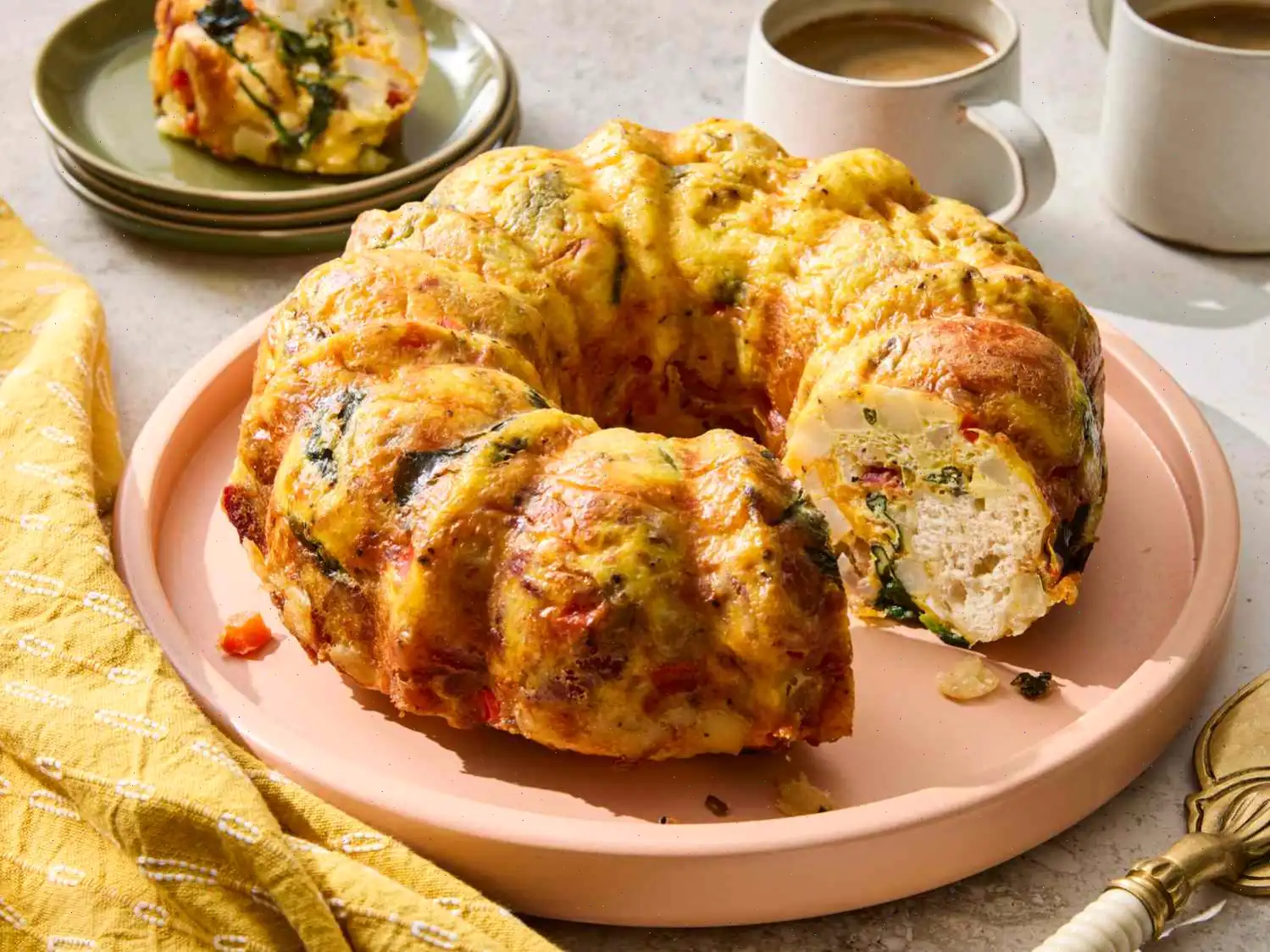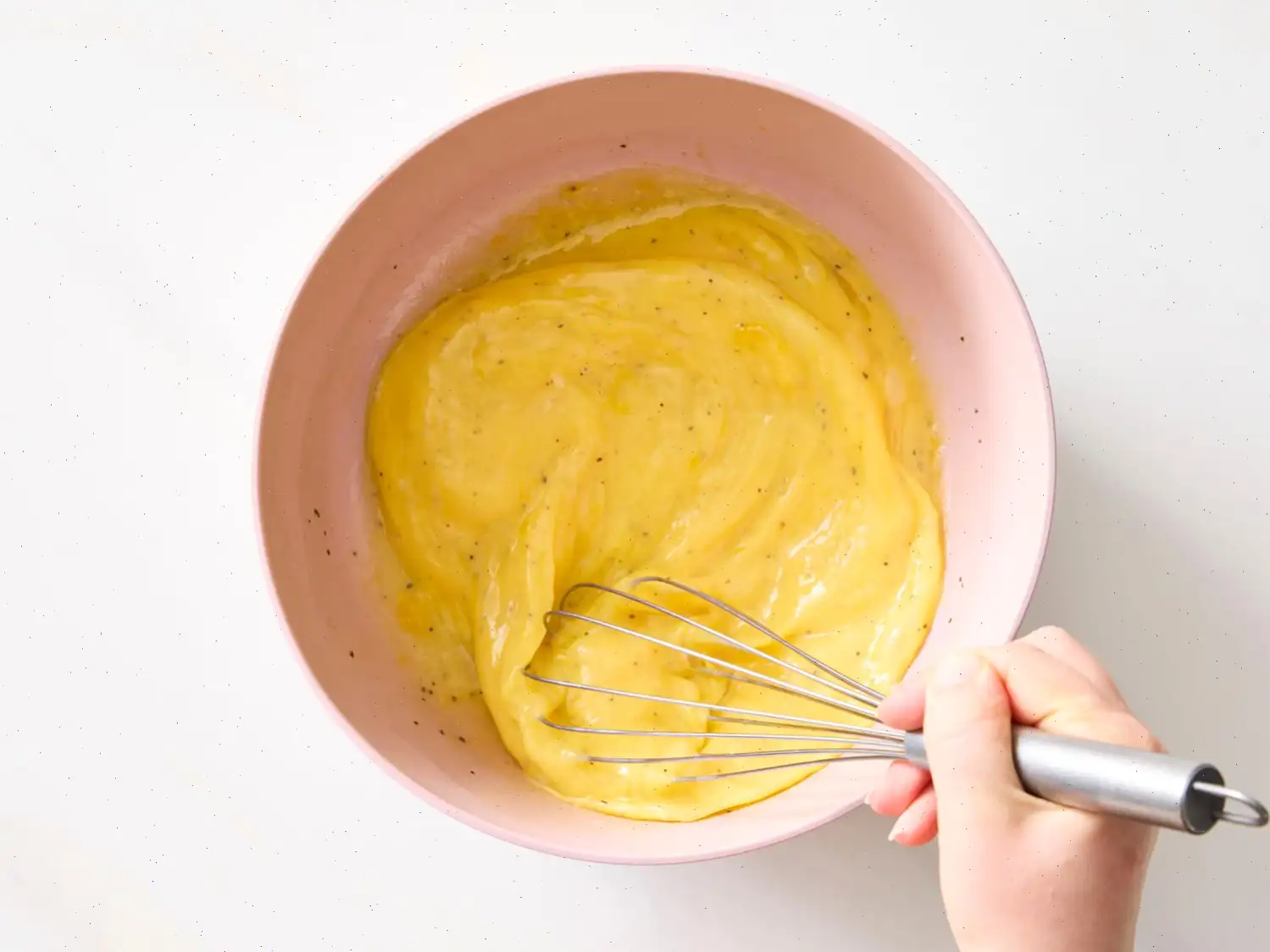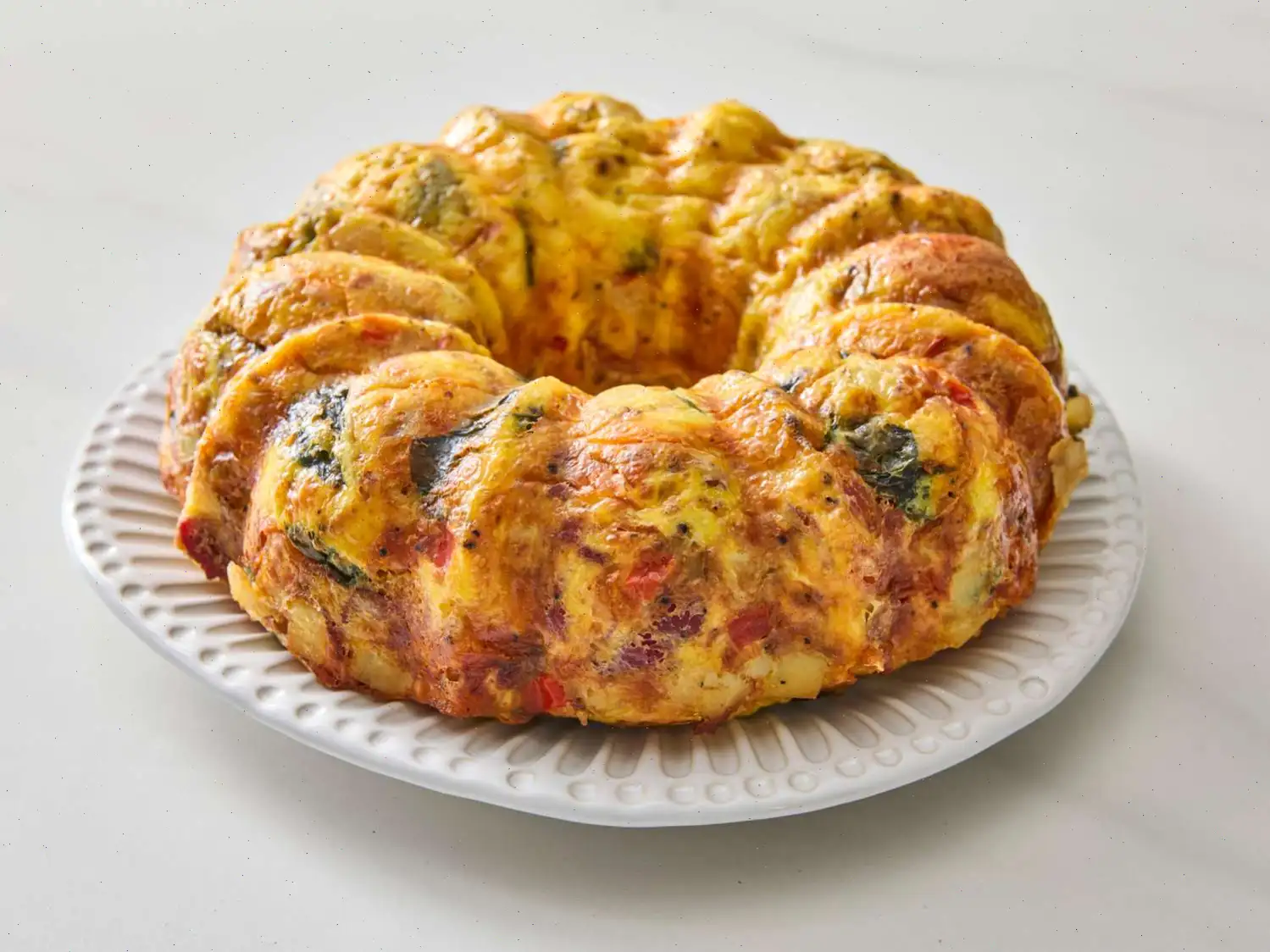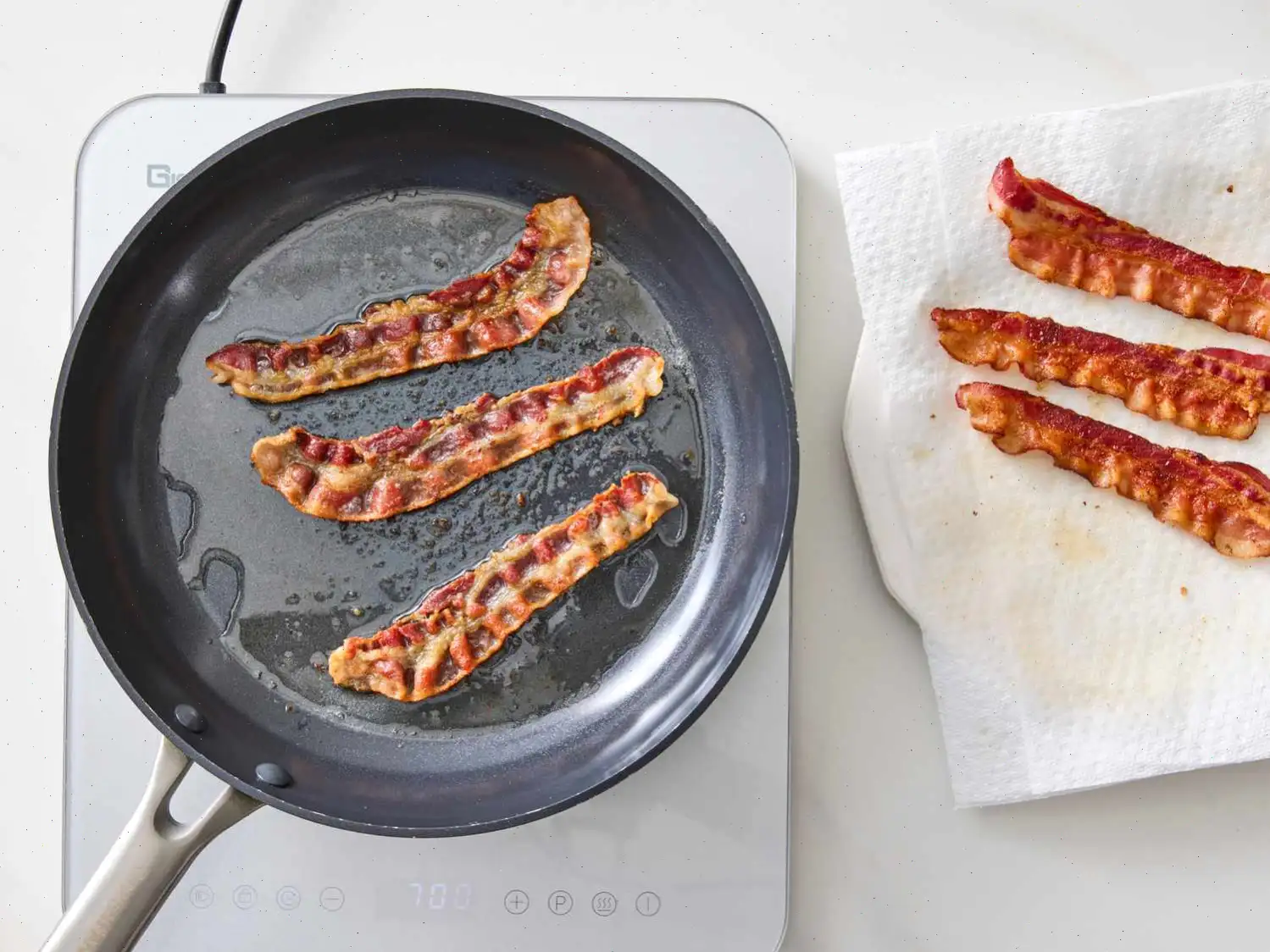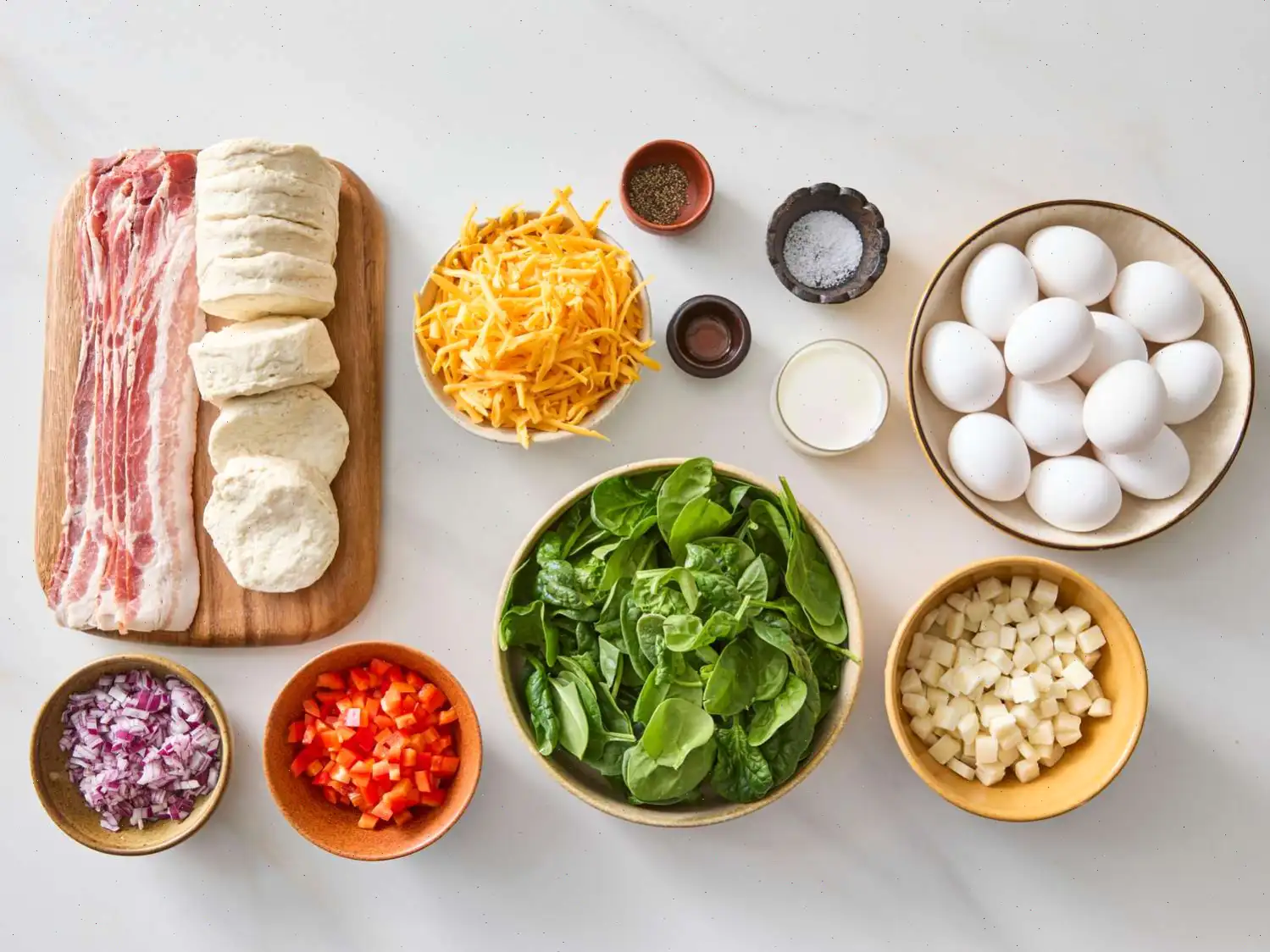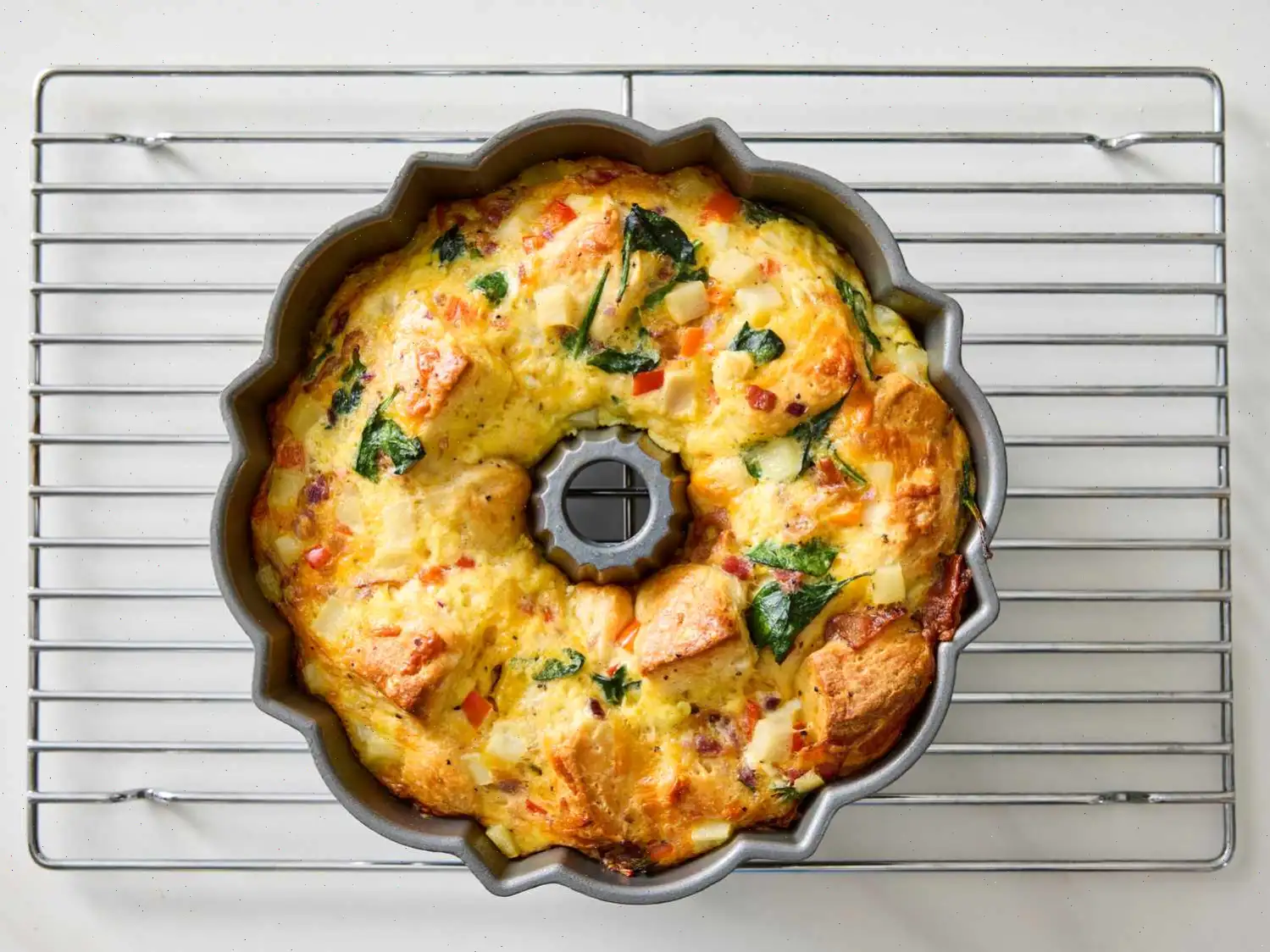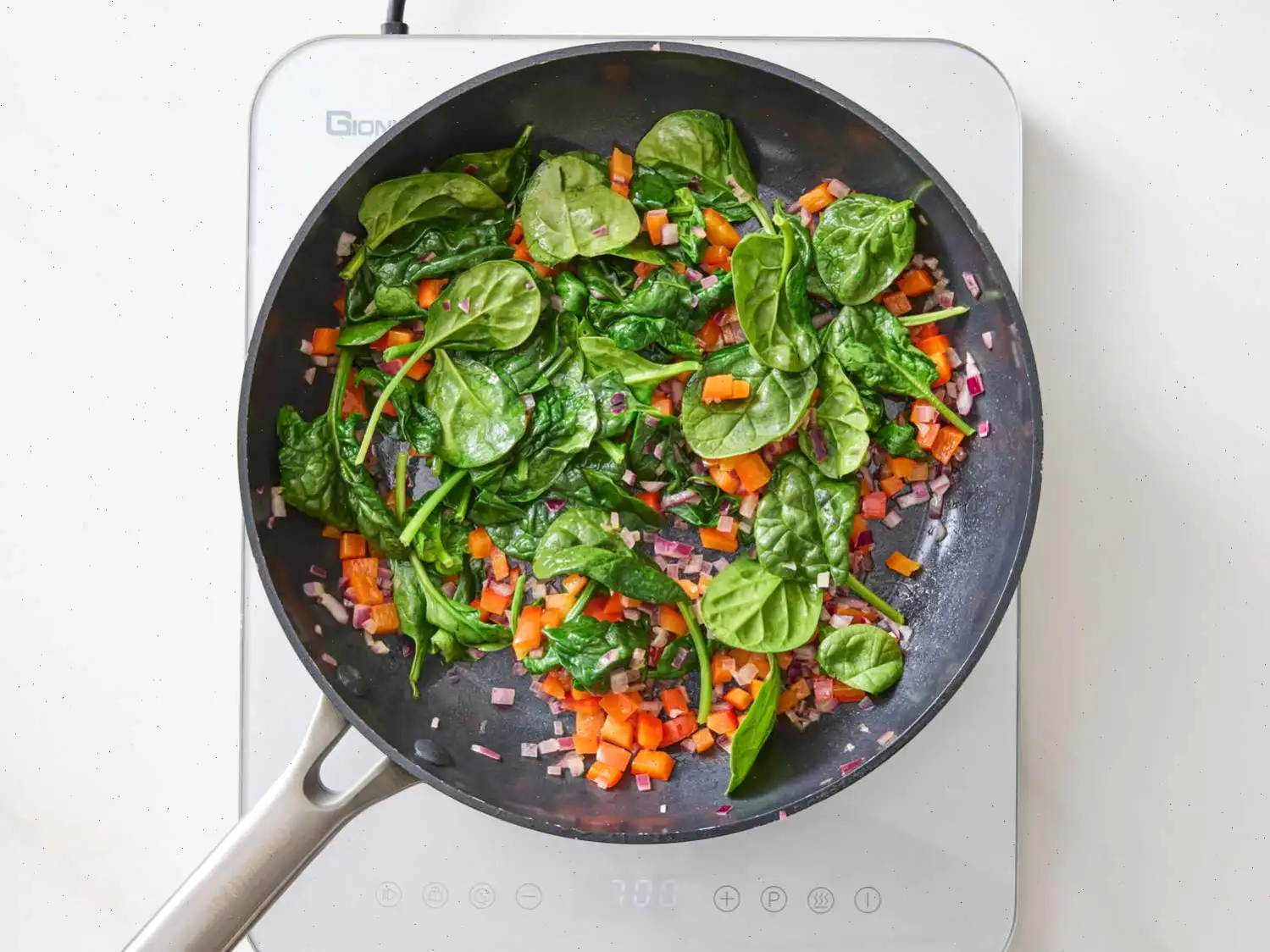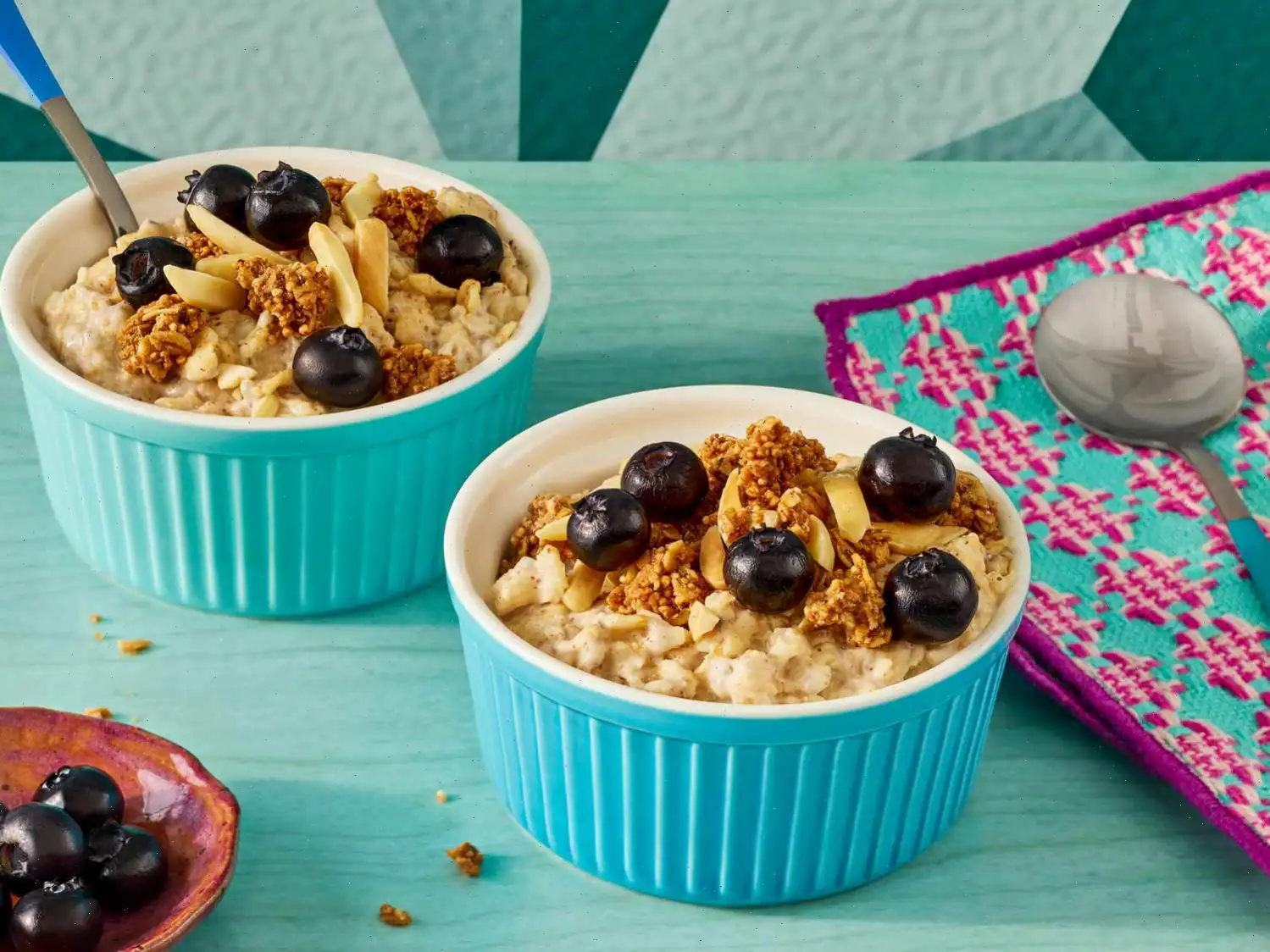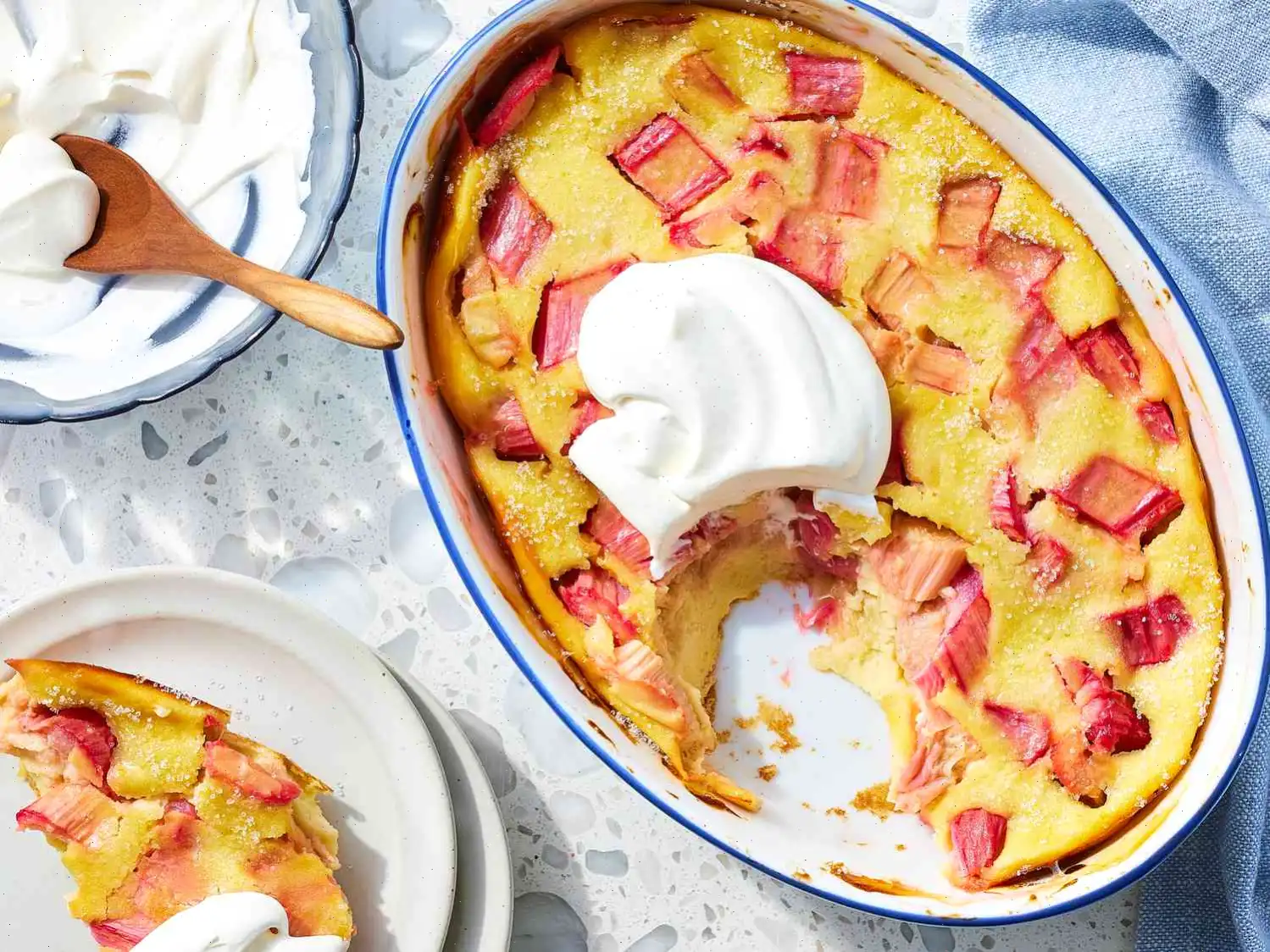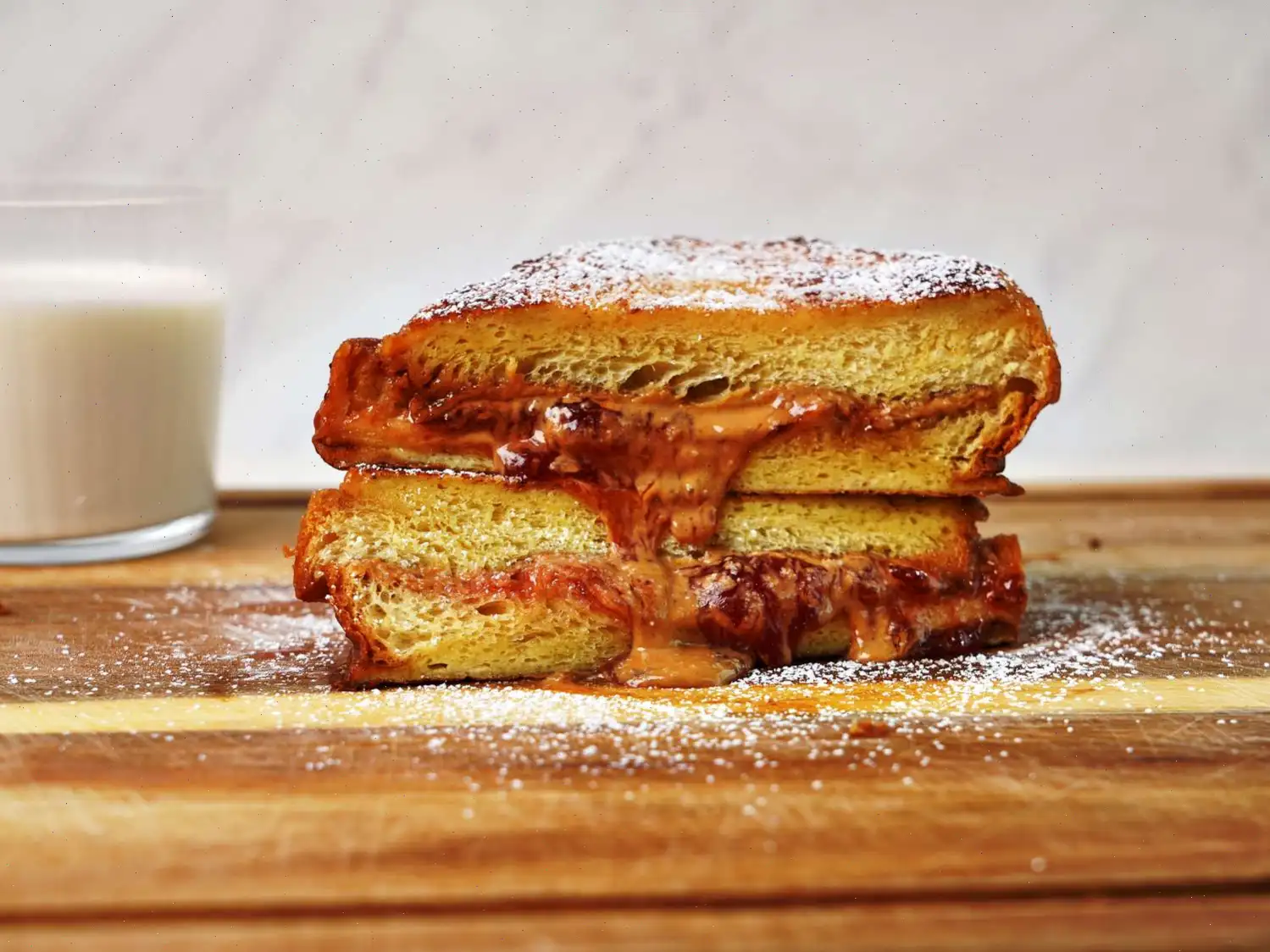
Breakfast Biscuit Bundt Cake Recipe
Ingredients
- Cooking spray
- 6 slices bacon
- 1 cup chopped red onion
- 1 cup chopped red bell pepper
- 3 cups packed baby spinach
- 12 large eggs
- 1/2 cup whole milk
- 2 teaspoons bottled hot pepper sauce
- 1/2 teaspoon salt
- 1/2 teaspoon freshly ground black pepper
- 1 (16.3-ounce) can refrigerated biscuits (such as Pillsbury Grands), quartered
- 1 (8-ounce) package shredded Cheddar cheese
- 1 1/2 cups frozen diced hash brown potatoes
Directions
- Gather all the ingredients and preheat your oven to 350F (175C). Generously grease a 10-inch nonstick Bundt pan with cooking spray.
- In an extra-large skillet, cook bacon over medium heat until crisp, about 8 to 10 minutes. Once done, drain the bacon on paper towels and crumble it once it's cool enough to handle.
- Remove all but 1 tablespoon of bacon drippings from the skillet. Add the chopped onion and bell pepper, cooking and stirring until tender, about 4 minutes. Then add the spinach and cook for another 1 to 2 minutes, until it wilts. Set the mixture aside to cool.
- In a large bowl, whisk together the eggs, whole milk, hot sauce, salt, and freshly ground black pepper.
- To the egg mixture, add the crumbled bacon, cooked vegetables, quartered biscuit pieces, shredded cheese, and frozen hash browns. Toss everything together until well combined.
- Pour the mixture into the prepared Bundt pan, making sure it's evenly distributed. Cover the pan with foil and bake for 30 minutes.
- After 30 minutes, remove the foil and continue baking for an additional 25 to 30 minutes, or until a knife inserted into the center comes out clean. The internal temperature should reach 195F to 200F (91C to 93C).
- Once baked, let the Bundt cake cool on a wire rack for 15 minutes. Then, run a thin silicone spatula around the edges and the middle of the cake to help it release from the pan.
- Carefully invert the cake onto a platter. If any pieces of the crust stick to the pan, remove them with the spatula and place them on top of the cake.
Nutrition Facts
Per Serving:
- Calories: 542
- Total Fat: 29g (37% Daily Value)
- Saturated Fat: 10g (52% Daily Value)
- Cholesterol: 317mg (106% Daily Value)
- Sodium: 1344mg (58% Daily Value)
- Total Carbohydrate: 46g (17% Daily Value)
- Dietary Fiber: 3g (11% Daily Value)
- Total Sugars: 6g
- Protein: 25g (50% Daily Value)
- Vitamin C: 38mg (42% Daily Value)
- Calcium: 305mg (23% Daily Value)
- Iron: 4mg (21% Daily Value)
- Potassium: 497mg (11% Daily Value)
* Percent Daily Values are based on a 2,000 calorie diet. Your daily values may vary depending on your calorie needs.

The Story Behind Breakfast Biscuit Bundt Cake
The Breakfast Biscuit Bundt Cake is a modern American innovation that reimagines the classic breakfast casserole. Its roots can be traced to the Southern tradition of biscuits and strata-style egg bakes. In the early 20th century, home cooks began experimenting with layering bread or biscuit pieces with eggs, cheese, and vegetables for a hearty, visually appealing breakfast. The Bundt pan, popularized in the United States in the 1950s, added a dramatic twist to this comforting dish, giving it a distinctive ring shape that makes it perfect for gatherings and brunches.
Regional Characteristics
This dish is particularly popular in the Southern and Midwestern United States, where biscuits are a breakfast staple. In the South, cooks often incorporate regional ingredients such as smoked bacon, cheddar cheese, and local vegetables like bell peppers and onions. In the Midwest, variations may include hash browns or sausage for a heartier meal. While the core concept remains the same, the choice of cheese, vegetables, and seasoning reflects the local culinary preferences, making each version slightly unique to its region.
What Sets It Apart from Similar Dishes
While Breakfast Biscuit Bundt Cake shares similarities with strata, breakfast casseroles, and egg bakes, its unique feature is the use of refrigerated biscuit pieces baked in a Bundt pan. Unlike traditional strata, which usually uses sliced bread and a rectangular pan, the biscuit version results in a lighter, fluffier texture with pockets of melted cheese and crispy edges. The Bundt shape also allows for an even distribution of ingredients and a visually striking presentation, making it stand out from more conventional breakfast bakes.
Where Its Typically Served
Breakfast Biscuit Bundt Cake is commonly served at weekend brunches, holiday breakfasts, and potluck gatherings. Its eye-catching appearance and convenient sliceable shape make it ideal for feeding larger groups. Cafs and bed-and-breakfast establishments have also embraced this dish as a specialty brunch item, often paired with fresh fruit, coffee, or mimosas. In family settings, it is a favorite for Sunday mornings when a warm, satisfying breakfast is desired with minimal individual plating.
Interesting Facts
- The Bundt pan used in this recipe is inspired by European kugelhopf molds, traditionally used for sweet breads and cakes.
- The combination of biscuit, eggs, cheese, and vegetables creates a dish that can be served hot or at room temperature, making it versatile for meal prepping.
- Variations with added hot sauce, herbs, or smoked meats reflect the customizable nature of this dish, allowing cooks to adapt it for different flavor profiles.
- Despite its indulgent appearance, the cake packs protein from eggs and cheese, along with vitamins from vegetables, making it a surprisingly balanced breakfast option.
- Its marbled, layered appearance not only adds aesthetic appeal but also ensures that each slice contains a mix of textures and flavors.


